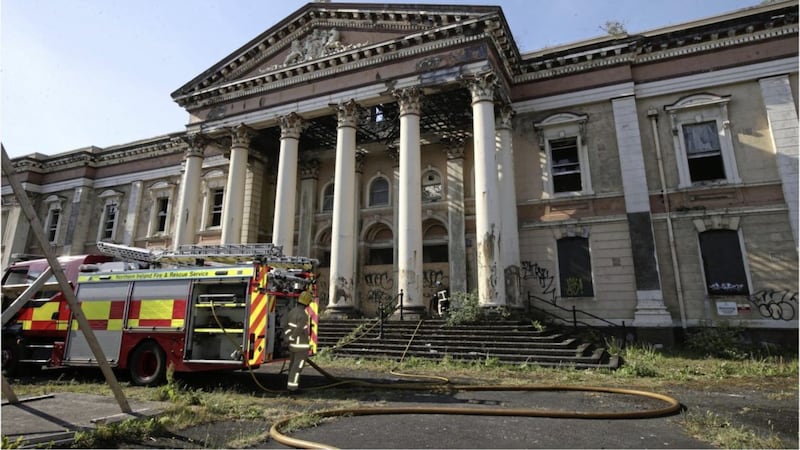CRUMLIN Road courthouse is a monument to the criminal neglect the planners have for what really matters from our shared past. As noted recently in Private Eye: “Few cities neglect their landmark buildings more than Belfast, where the planning system is fragmented and enforcement toothless.”
This, after all, is the same place that allowed a former residence of Nobel prize-winning poet, Seamus Heaney to be bulldozed, turned a blind eye towards the wholesale destruction of the city’s Georgian legacy and enthusiastically welcomed the demolition of the Grand Central hotel in Royal Avenue and its replacement with the undistinguished and unlovely CastleCourt centre.
Convenient “mystery fires” left Derry’s famous Tillie and Henderson shirt factory (mentioned in Marx’s Das Kapital) and the art deco splendour of North Street arcade in smoking ruins after years of dereliction.
Another fire this week has caused further untold damage to the courthouse, a neoclassical landmark built by Sir Charles Lanyon in 1840s.
It closed in 1998 after nearly 150 years of judicial history. Its courtrooms bore testimony to many of the darkest days of the Troubles, including the infamous supergrass trials of the 1980s which saw the effective internment of multiple terrorist suspects on the word of single informants from among their ranks.
They included Christopher Black, Raymond Gilmore and, on the loyalist side, Budgie Allen. All the convictions were subsequently overturned on appeal, but it kept suspects off the streets for a while and were a major source of “ker-ching” for m’learned friends, who did very well out of the system.
I covered much of the trial of 32 of those fingered by INLA supergrass Harry Kirkpatrick. One afternoon I noticed the moustachioed informer seemed to be winking in my direction. The nerve of the man, I said to veteran court reporter, Mickey Donnelly. Mickey put me right. Apparently Harry O, as he was known, was given some valium to get him through his testimony and cross-examination in the witness box. But by mid-afternoon, it was wearing off and he returned to his usual nervous tics.
Unlike the well-preserved and restored jail across the road, the courthouse has been flogged off more than once to developers with grandiose ideas of luxury hotels with little by way of on-site security to protect the iconic building. Now it’s up for sale again.
It’s time Belfast city council and the Department for Communities stepped in and stopped offloading this prized landmark to property speculators.
Ulster Architectural Heritage is bang on the money. It should be repossessed in a compulsory purchase order and brought back into public ownership for a proper restoration before another arson attack destroys it beyond redemption.
The public response to the fire in the Bank Buildings shows that people do care about the built heritage of this city. We just need our elected politicians to do something tangible to protect the history they’re so fond of fighting over.
* * *
THE uneven easing of lockdown restrictions across these isles is doing little to inspire public confidence that governments know what they’re doing. Stormont just better hope that the good weather doesn’t return any time soon or the open rebellion witnessed in some of our parks and beaches will increase.
With holidays abroad still looking dubious, we may see a revival in the bucket-and-spade local holidays. My children used to find it hilarious that my own family’s normal destination was Bangor. “That’s like, 12 miles away,” they said incredulously.
Ah, but it was a proper seaside resort then, where lots of families spent the summer happily, playing on the sand, buying candy floss and ice creams and going to Barry’s of a wet afternoon.
Sadly demolished now, it was a magical castle-like edifice on the seafront, patrolled by the fearsome owner, Mrs Minnie Delino, who carried huge bunches of keys like a prison wardress. My cousin pursued her round the building after he put sixpence in a machine that dispensed orange juice, but only got a cup of water.
“That water would cost you a thousand pounds if you were in the desert,” she replied. For her, the customer was always wrong.
I learned to swim in a week of lessons at Pickie Pool, sponsored by Bangor Maid ice-cream. And if you could stand the freezing temperatures of that seawater pool, you could stand anything an Irish summer would throw at you.
We eventually progressed to further afield Newcastle, Ballycastle and even Portstewart, which seemed almost exotic then. Who needs Spain and France for your hols? Er, me.








